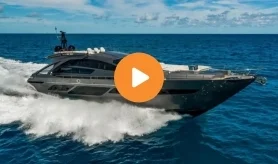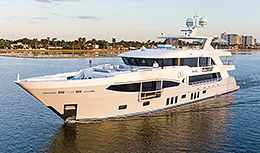- Alaskan Yachts
- Azimut Yachts
- Back Cove Yachts
- Beneteau Yachts
- Benetti Superyachts
- Bertram Yachts
- Boston Whaler
- Broward Yachts
- Buddy Davis Sportfish
- Burger Yachts
- Cabo Yachts
- Catamarans
- Carver Motoryachts
- Center Console
- Chris-Craft Yachts
- Cruisers Yachts
- DeFever Trawlers
- Dufour Sailboats
- Fairline Yachts
- Feadship Yachts
- Ferretti Yachts
- Formula Yachts
- Fountaine Pajot Cats
- Grady-White
- Grand Banks Trawlers
- Hargrave Yachts
- Hatteras Yachts
- Hinckley Picnic Boats
- Horizon Yachts
- Hydra-Sports
- Intrepid Boats
- Jarrett Bay Sportfish
- Jeanneau Yachts
- Kadey-Krogen Trawlers
- Lazzara Yachts
- Lekker Boats
- Luhrs Sportfish
- Marlow Yachts
- Maritimo Yachts
- Marquis Yachts
- McKinna Motoryachts
- Meridian Yachts
- Midnight Express
- MJM Yachts
- Mochi Craft
- Neptunus Motoryachts
- Nordhavn Trawlers
- Nordic Tugs
- Numarine Yachts
- Ocean Alexander Yachts
- Offshore Yachts
- Outer Reef
- Oyster Sailing Yachts
- Pacific Mariner Yachts
- Palmer Johnson Yachts
How To Plan A Multi-Day Boat Trip
Use our checklist for your next boating vacation.
Forget road trips — it’s the year of boat trips. While pandemic travel is still a big question mark, traveling by yacht or boat is a safe and socially distanced way to visit destinations. Vacationing on your boat is nothing new, but for first-timers or new boat owners, it can be a big deal.
Arranging a boat trip is a little (a lot) different than planning a road trip. It’s not as easy as jumping in a car, stopping at McDonald’s, and driving on cruise control for 200 miles. Planning a multi-day vacation on a boat takes time and includes verifying boat maintenance, updating safety and navigation equipment, and monitoring the weather. The first step is to get organized, so we created a checklist for planning a vacation on your boat. As good ole Benjamin Franklin said, by failing to prepare you are preparing to fail.
Choose a boater friendly destination + time of year

The thing about boating (versus road trips) is that weather can make or break your trip. As part of your pre-planning stage, search for destinations that are boater friendly at certain times of the year. Summer is usually a boater’s paradise — long days, sunny skies, and calmer waters make cruising a comfortable experience. For example, if you depart from Fort Lauderdale, Florida, you’ll arrive in the Bahamas before sunset and vice versa for the return trip (if you run at high speed) on a Friday afternoon in June. Once you choose a boat-friendly destination, then you should start planning logistics and excursions.
Chart your journey

Updated technology and navigation systems make it easy to chart a boating trip, but it’s still smart to keep a paper chart of your journey. Ensure chart and electronics are the most recent version to reflect navigational hazards such as channel changes due to dredging, erosion, landslides, or construction. Study your route and be aware of shallow areas, currents, and shipping lanes.
Don’t forget to map out fuel stations along the way. Unlike driving along a busy highway, accessible boating gas stations are more spread out. When planning your fuel stops, allow extra expenditures for bad weather, high winds, or spontaneous side trips without cutting it too close.
Reserve a Boat slip or find mooring fields

Sleeping on a boat is like RV camping (only better). Once you choose a destination(s), reserve a dock slip or find a mooring field that’s convenient for you. If you have a tender or dinghy, tying up to a mooring buoy is a cost-effective option, but they’re usually on a first-come, first-served basis. When anchoring, make sure to understand the currents and tidal exchange of the area to avoid nasty surprises. Always have a backup plan for sleeping arrangements.
Check boat maintenance + safety equipment — double-check everything

Boat maintenance is one of the most important steps to planning a multi-day boat trip. Brush up on your maintenance skills and complete a tune-up before embarking on a multi-day journey. Check that bilges, fluids, and batteries are at the correct levels. If anything is unexpectedly low or too high, troubleshoot before you go.
Check hose clamps and fittings, wiring and terminals, throttle and shift cables, steering cables, and engine zincs for corrosion, condensation, and wear-and-tear. Make sure the anchor and lines are in good condition, and if you have an extra anchor, bring it with you. And don’t forget to inspect and test drive the dinghy. If you bought a new boat through Denison, contact your yacht broker or the service department to schedule a second eye or opinion.
Once you perform boat maintenance, go through safety equipment and checks. Store enough PFDs for everyone on board, and then some. Check that you have non-expired flares, fire extinguishers, first aid kits, and personal flotation devices onboard the vessel. Test the VHF radio and pack a pair of binoculars.
Last but not least, organize all boat documentation, including fishing license, park pass, boating safety certificate, and operator’s license, as required by your state. Once everyone’s on board, give family or guests a safety run through and float plan before leaving the docks.
Pack extra food, water, clothing, and safety materials

Less is not more in the instance of a boat trip. Boatbuilders, such as Beneteau or Bertram, have mastered the art of optimizing space for storage. Boats and yachts can store way more items than you may expect. Stock up on food, water, toilet paper, sunscreen, spare fluids, weather dependent clothing, and safety materials. There’s not going to be a McDonald’s or Starbucks every 10 minutes.
Check all tanks

As you would when beginning a road trip, fill the tank before sailing away. Check the fuel line and hose clamps for cracking or damage, then fill up the gas tank. Don’t forget to top off the water tank and thoroughly pump out the waste tank. We know, we know, this is part is a no brainer for boat owners. But it’s easy to overlook the little things when in the rush to get on the water.
Go for it

Once you’ve confidently checked off the above (twice), throw on the sunglasses, turn up the tunes, and start your engines. You’re ready for the ultimate getaway. Whether you’re cruising in a sailboat, catamaran, trawler, sportfish, or motor yacht, you’re sure to have a fun and memorable vacation. Contact a Denison yacht broker to find your next boat for safe travel in 2021.






